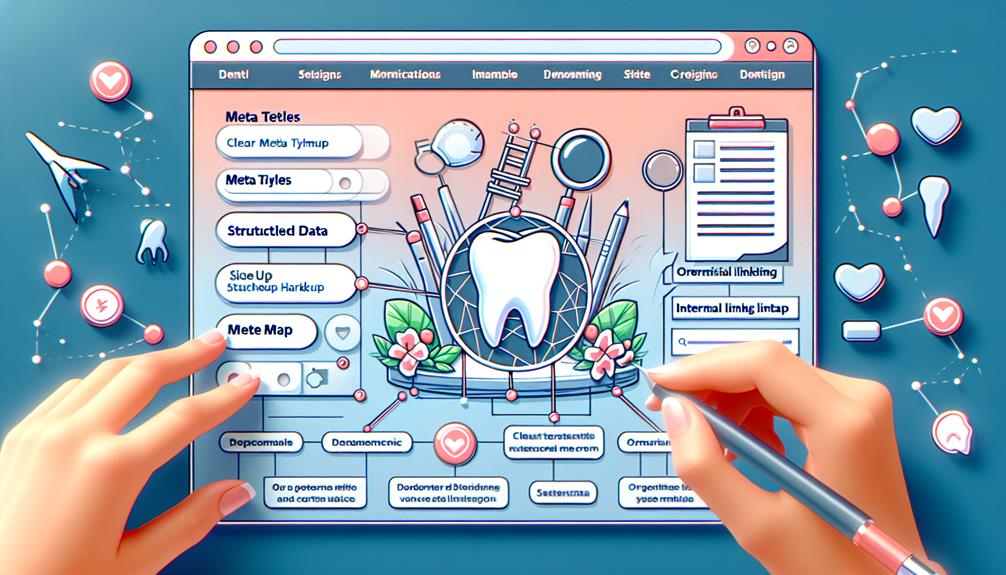Have you ever wondered if the success of a dental website hinges on technical SEO aspects?
In the competitive online landscape, ensuring that your dental practice’s website is optimized for search engines can significantly impact your online visibility and patient acquisition.
When it comes to navigating the digital realm, certain technical SEO elements play a vital role in enhancing your website’s performance and ranking potential.
Understanding which aspects are crucial for dental websites could be the key to unlocking greater online success and attracting more patients to your practice.
Site Speed Optimization
To enhance user experience and boost search engine rankings, optimizing site speed is crucial for dental websites. Improving performance can lead to reduced bounce rates, keeping visitors engaged and increasing the likelihood of conversions. One key strategy for enhancing site speed is to compress images without compromising quality. Large image files can significantly slow down loading times, impacting user satisfaction. Utilizing tools like Photoshop or online image compressors can help strike a balance between visual appeal and quick loading speeds.
Another effective method is to enable browser caching, allowing returning visitors to load your site faster by storing static resources locally. This reduces the need for repeated downloads, enhancing overall performance. Additionally, minimizing HTTP requests by combining CSS and JavaScript files can further streamline loading times. By optimizing site speed through these strategies, dental websites can create a seamless user experience, ultimately leading to higher search engine rankings and lower bounce rates.
Mobile-Friendly Design
When optimizing your dental website for mobile devices, ensure you have a responsive web layout that adapts seamlessly to various screen sizes.
User-friendly navigation is key to enhancing the mobile user experience, making it easy for visitors to find information efficiently.
Fast page loading speeds are crucial for mobile-friendliness, as users expect quick access to your site’s content on their devices.
Responsive Web Layout
Implementing a responsive web layout is crucial for ensuring optimal user experience across different devices accessing your dental website. A responsive design adapts to various screen sizes, providing a seamless browsing experience. This not only enhances user satisfaction but also positively impacts your SEO efforts by reducing bounce rates and improving site engagement. Ensuring cross-browser compatibility and ADA compliance further enhances accessibility for all users. Additionally, incorporating SEO-friendly architecture and custom features tailored to your dental practice can set your website apart. By focusing on a responsive web layout, you create a strong foundation for attracting and retaining visitors, ultimately contributing to the success of your online presence.
| Key Aspects | Details | Benefits |
| Responsive Design | Adapts to different devices | Enhanced user experience |
| Cross-Browser Compatibility | Consistent performance across browsers | Increased site accessibility |
| ADA Compliance | Ensures accessibility for all users | Broadens user reach |
| SEO-Friendly Architecture | Optimized for search engines | Improved search rankings |
User-Friendly Navigation
Crafting a seamless user-friendly navigation experience is essential for optimizing your dental website for mobile devices. To ensure your users can easily find what they need, focus on the following:
- Navigation Structure: Simplify your menu and ensure it’s easy to navigate with minimal clicks.
- Menu Organization: Arrange your menu logically, prioritizing essential pages like services, contact information, and appointment scheduling.
- Accessibility: Make sure all menu items and buttons are large enough to tap on a mobile screen easily, enhancing user experience.
Fast Page Loading
To enhance the performance and user experience of your dental website on mobile devices, prioritize optimizing for fast page loading through mobile-friendly design strategies. Fast page loading is crucial to improve performance and reduce bounce rates.
Mobile users expect websites to load quickly, and a mobile-friendly design ensures that your site is responsive and loads efficiently on various devices. To achieve fast loading times, focus on optimizing images, leveraging browser caching, and minimizing server response times.
Implementing techniques like lazy loading and minimizing unnecessary scripts can also contribute to a speedier website. By prioritizing fast page loading through mobile-friendly design, you create a seamless user experience that keeps visitors engaged and decreases bounce rates, ultimately benefiting your dental practice.
Metadata Enhancement
Enhancing metadata on your dental website can significantly boost its search engine visibility and user engagement. By focusing on metadata enhancement, you can improve the way your website appears in search engine results and entice users to click through to your site.
Here are three key strategies to enhance your metadata effectively:
- Keyword Optimization: Conduct thorough keyword research to identify relevant terms that your target audience is searching for. Incorporate these keywords strategically into your title tags, meta descriptions, and image alt text to improve your website’s relevance for search queries.
- Title Tags and Meta Descriptions: Craft compelling and concise title tags that accurately describe the content of each page. Similarly, write engaging meta descriptions that provide a brief summary of the page’s information to entice users to click.
- Schema Markup: Implement schema markup to provide search engines with additional context about your content, which can lead to enhanced search results with rich snippets and increased visibility for your dental website.
Schema Markup Implementation
When implementing Schema Markup on your dental website, understanding the benefits, types, and best practices is crucial.
By utilizing Schema, you can enhance your website’s visibility in search engine results and provide users with more informative snippets.
Implementing Schema correctly can lead to higher click-through rates and improved SEO performance for your dental practice.
Benefits of Schema
Implementing Schema markup on your dental website can significantly enhance its visibility and relevance in search engine results. By incorporating Schema, you can boost your local SEO efforts and improve your chances of ranking higher on Google.
The benefits of Schema extend beyond just basic SEO; it also enables your website to qualify for rich snippets, which are highlighted search results that provide users with quick and relevant information. Additionally, Schema markup helps search engines understand the content on your site better, leading to more accurate categorization and increased chances of appearing in relevant searches.
Types of Schema
To further optimize your dental website’s visibility and relevance in search engine results, exploring the various types of Schema markup implementation is crucial for enhancing your online presence.
Implementing Schema for Local SEO can greatly benefit your dental practice by increasing local visibility and attracting nearby patients.
By utilizing Schema markup for your dental services, you can enhance your website’s appearance in search results with rich snippets, providing users with quick, informative previews that can drive more traffic to your site.
Incorporating Schema markup strategically throughout your website can help search engines better understand your content, ultimately improving your overall SEO performance and making your dental services more accessible to potential patients seeking oral care.
Schema Best Practices
For effective Schema markup implementation on your dental website, precision and strategic placement are key factors in boosting your SEO performance and enhancing user engagement.
Schema Best Practices:
- Local SEO Strategy: Incorporate local business schema markup to improve local search visibility and attract nearby patients.
- Conversion Rate Optimization: Utilize schema markup for reviews, ratings, and testimonials to build credibility and increase conversions.
- Content Marketing & Link Building: Implement schema markup for articles, FAQs, and case studies to enhance content visibility and attract quality backlinks, boosting your website’s authority.
SSL Certificate Installation
Ensuring the secure transmission of data on your dental website involves the installation of an SSL certificate. This certificate encrypts information exchanged between your site and visitors, safeguarding sensitive data such as patient details or appointment bookings. Data security is paramount in maintaining trust with your patients and complying with privacy regulations.
When your website is secured with SSL encryption, it displays a padlock icon in the browser’s address bar, assuring visitors that their information is safe from potential cyber threats.
SSL certificate installation not only enhances data security but also contributes positively to your website’s SEO performance. Search engines like Google prioritize websites with SSL certificates, considering them more trustworthy and secure. This can lead to improved search rankings and increased organic traffic to your dental site.
Additionally, SSL encryption helps prevent data breaches and cyber-attacks, giving both you and your patients peace of mind when interacting with your online platform. Make sure to regularly update and maintain your SSL certificate to ensure ongoing protection for your dental website.
Image Optimization
Implementing effective image optimization techniques can significantly enhance the performance and user experience of your dental website. By focusing on alt text optimization, file compression, lazy loading implementation, and retina display optimization, you can ensure that your site is visually appealing and loads quickly for visitors.
Here are some key strategies to optimize images on your dental website:
- Alt Text Optimization: Ensure every image on your website has descriptive and keyword-rich alt text to improve accessibility and help search engines understand the content of the images.
- File Compression: Reduce the size of your image files without compromising quality through compression techniques, which can speed up loading times and improve overall site performance.
- Lazy Loading Implementation and Retina Display Optimization: Lazy loading images can help prioritize loading visible content first, while optimizing images for retina displays ensures high-quality visuals for users with high-resolution screens. These techniques collectively enhance user experience and SEO performance on your dental website.
Frequently Asked Questions
Can You Provide Examples of Specific Dental Websites That Have Successfully Implemented Schema Markup for Better Search Engine Visibility?
When looking for examples of successful schema markup implementation on dental websites, consider case studies that showcase specific strategies. Dive deep into implementation tips and learn how to measure the impact of schema markup for improved search engine visibility.
How Can Dental Websites Ensure That Their SSL Certificate Is Properly Installed and Maintained for Optimal Security?
Ensure your dental website’s SSL certificate is correctly installed and maintained for optimal security. Regularly update and monitor cybersecurity measures to protect data. Comply with website security and data protection regulations for a safe online environment.
What Are Some Common Mistakes to Avoid When Optimizing Images on a Dental Website for Improved Performance and User Experience?
Feeling overwhelmed with image optimization? Avoid common mistakes to boost performance and enhance user experience on your dental website. Focus on proper sizing, alt text, and file formats for better results.
Are There Any Specific Metadata Best Practices That Dental Websites Should Follow to Stand Out in Search Engine Results?
To stand out in search results, focus on keyword optimization, content strategy, link building, and mobile optimization. Nail metadata practices for better visibility. Craft compelling titles, meta descriptions, and structured data to boost your dental website’s SEO performance.
How Can Dental Websites Effectively Incorporate Local SEO Strategies to Attract More Patients in Their Specific Geographic Area?
To effectively attract more patients in your specific geographic area, focus on incorporating local SEO strategies. Use social media and patient testimonials to engage with your community. Ensure your presence on local directories and optimize your Google My Business listing.
Conclusion
So, now you know the key technical SEO aspects crucial for dental websites. Remember, neglecting these elements is a great way to ensure your website remains buried in the depths of search engine results.
But hey, who needs new patients anyway, right? Keep optimizing, keep ranking, and watch your dental practice thrive online.
It’s your choice – sink or swim in the vast sea of digital competition.

Suraj Rana is a renowned Dental SEO Expert, deeply committed to elevating dental practices in the online landscape. With a profound understanding of technical SEO, he specializes in tailoring on-page optimization strategies specifically for the dental industry. Suraj’s extensive experience spans across various sectors, but his passion truly lies in transforming the digital presence of dental clinics. His expertise in dental-specific search engine optimization, combined with a data-driven approach, empowers him to develop strategies that significantly increase organic traffic, enhance search engine rankings for dental-related keywords, and ultimately drive business growth for his dental clients. Suraj Rana’s unique blend of SEO skills and dedication to the dental field make him an invaluable asset to any dental practice looking to thrive online.


